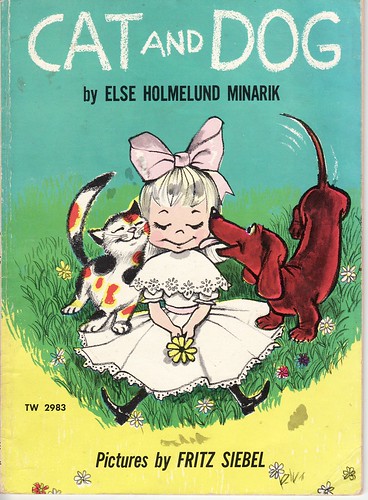Cat and Dog
by Else Holmelund Minarik, Pictures by Bryan Langdo
1960 (2005) | 32 pages | Easy Reader (My First I Can Read Book)
by Else Holmelund Minarik, Pictures by Bryan Langdo
1960 (2005) | 32 pages | Easy Reader (My First I Can Read Book)
The version I read, however, is the 2005 version, whose illustrations were updated by Bryan Langdo. Langdo's interpretation changes the child, who is never mentioned in the text, from a girl to a boy, creates a more contemporary household setting, and includes more bold and bright colors, like the ones found in other newer easy readers.
The story itself goes like this. All around the house, the dog bullies the cat into doing what he wants by threatening to turn her into terrible things - a catball, a catcoat, and a catpie. The cat teases the dog back, threatening that he will get the house all wet, or be tied up outside, if he can't behave. Finally, they bond over digging up bones, and the little boy who owns them gives them each some food.
The dog and the cat each have personalities, and their dialogue taps into what children might imagine animals saying to each other. The story provides a sort of logical explanation for the sometimes strange behavior of cats and dogs chasing each other around the house.
The text uses repetition to reinforce certain phrases, such as "I will, I will," which gives the story a nice rhythm and also helps new readers to begin recognizing those simple sentences on sight. The illustrations, too, help to convey the message contained in the text. They are especially useful in helping kids to understand the made-up objects the dog talks about, such as the catcoat and catpie. Illustrating these ideas inside thought bubbles sends the message that they are made-up ideas and not real words.

I borrowed Cat and Dog from my local public library.
0 Comments on Review: Cat and Dog by Else Holmelund Minarik as of 1/1/1900
Add a Comment




